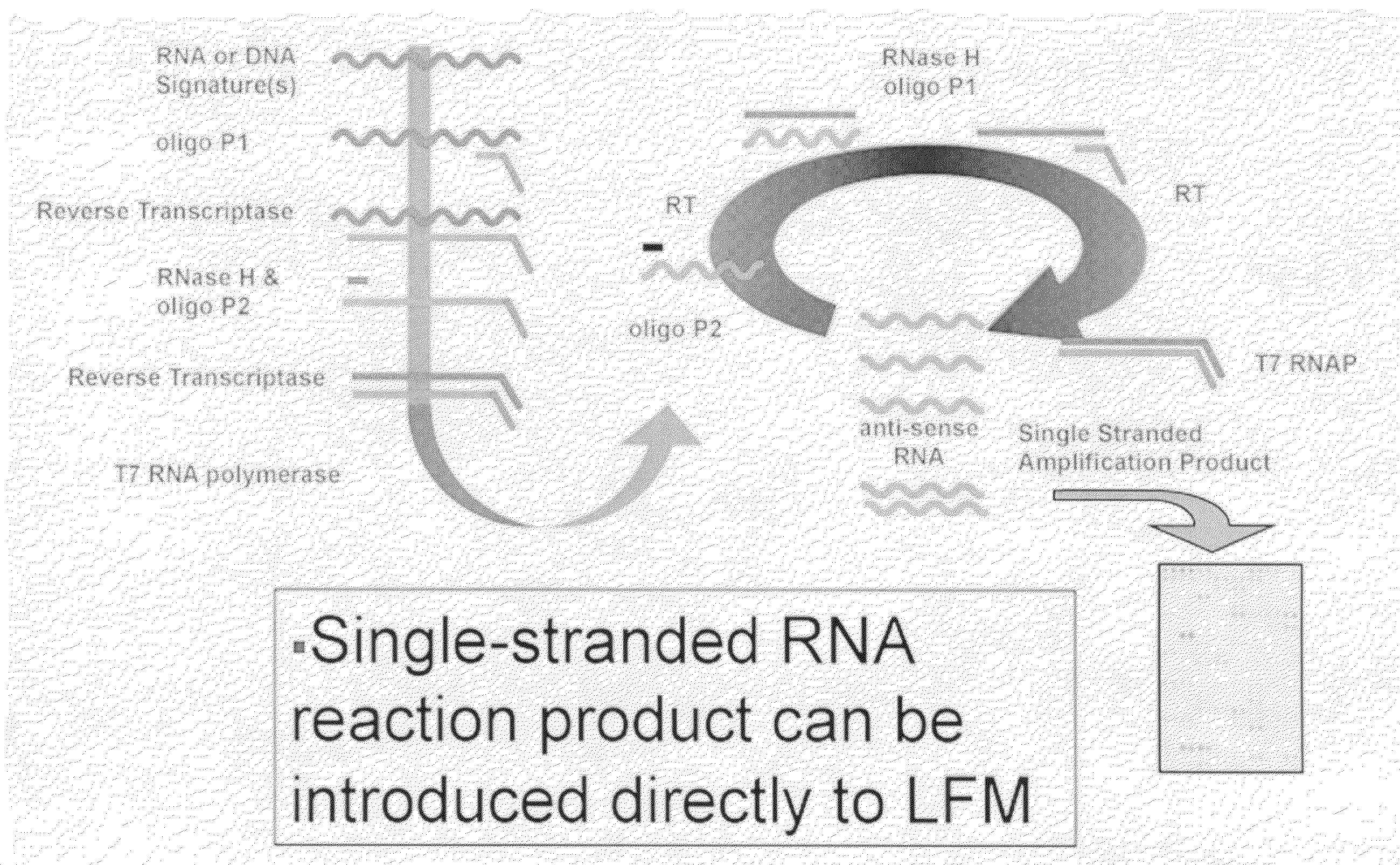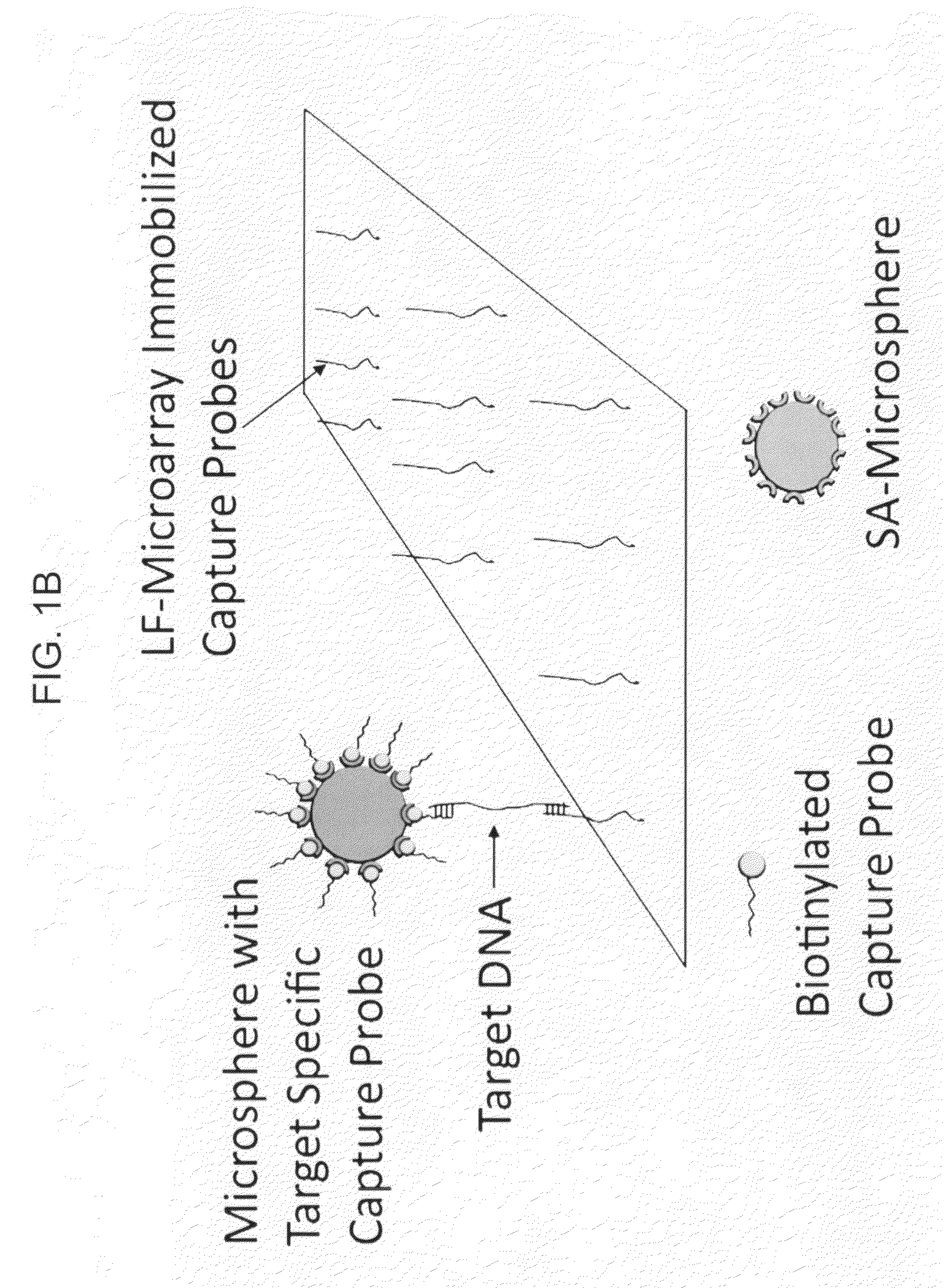Multiplexed lateral flow microarray assay for detection of citrus pathogens Xylella fastidiosa and Xanthomonas axonopodis PV citri
a technology of citrus pathogens and microarrays, applied in combinational chemistry, biochemistry apparatus and processes, library screening, etc., can solve the problems of citrus being susceptible to a large number of diseases, affecting the detection accuracy of citrus pathogens, etc., to achieve rapid detection, high efficiency of isothermal amplification techniques, and low cost
- Summary
- Abstract
- Description
- Claims
- Application Information
AI Technical Summary
Benefits of technology
Problems solved by technology
Method used
Image
Examples
example 1
Identification of Candidate Target Sequences for Xylella and Xanthomonas
[0081]Comparative Sequence Analysis:
[0082]Bioinformatics analysis of available genome sequences for Xylella and Xanthomonas species of interest and their nearest phylogenetic neighbors was conducted in order to identify candidate nucleic acid signatures for the development of strain specific detection assays for Xylella fastidiosa strain 9a5c and Xanthomonas axonopodis pv citri.
[0083]Target Candidates:
[0084]Based on favorable predicted melting temperatures and low secondary structure potentials within regions of interest, putative signatures (targets) were identified for further study. This effort identified six X. fastidiosa strain 9a5c candidate signatures and five X. axonopodis pv citri candidate signatures for further evaluation. For each candidate signature, NASBA primers were computationally designed, and the regions homologous to the pathogen derived target sequence are shown in Tables I and II.
TABLE I...
example 2
Initial Screening of Candidate Target Sequences
[0085]The candidate Xylella and Xanthomonas signatures identified in Example 1, supra, were screened for suitability in an LFM assay paradigm.
[0086]To screen candidate signature sequences for favorable behavior in lateral flow detection schemes, capture and detection probes were generated for all candidate signatures shown in Tables 1 and 2. The resulting oligonucleotides were deposited onto large pore nitrocellulose substrates for LFM device fabrication (FIG. 2A). The resulting LFMs were then used to screen oligonucleotide sequences for specific hybridization under standard LFM running conditions (FIGS. 2B, C).
[0087]These studies identified only two candidate capture / detection probe pairs exhibiting unfavorable cross hybridization to other candidates. They are XF2679 and XAC2743. XF0324 and XAC1509 based probes exhibited no detectable cross hybridization to each other or to other probe candidates. XF0324 and XAC1509 were therefore subj...
example 3
LFM Assay Detection of Xylella XF0324 and Xanthomonas XAC1509 Signatures
[0088]To establish the relative assay sensitivity afforded by the initial capture and detection oligonucleotides designed (Example 2), LFM assays for the detection of Xylella and Xanthomonas targets were conducted using synthetic oligonucleotide targets designed to carry the predicted sequence of signature / target amplicons.
[0089]Materials and Methods:
[0090]Synthetic RNA Targets for Xylella and Xanthomonas Targets:
[0091]To test NASBA primer designs and to define the amount of template required to obtain LFM-based detection following amplification, a test system was designed, based on a pUC57 vector carrying the XF0324 or XAC1509 signature / target sequences in front of a T7 RNA polymerase promoter. These constructs were used to program in vitro transcription reactions and the resulting RNA products purified and quantified. Dilution series experiments were conducted to define the limit of detection with respect to ...
PUM
| Property | Measurement | Unit |
|---|---|---|
| Sensitivity | aaaaa | aaaaa |
| Dynamic | aaaaa | aaaaa |
Abstract
Description
Claims
Application Information
 Login to View More
Login to View More - R&D
- Intellectual Property
- Life Sciences
- Materials
- Tech Scout
- Unparalleled Data Quality
- Higher Quality Content
- 60% Fewer Hallucinations
Browse by: Latest US Patents, China's latest patents, Technical Efficacy Thesaurus, Application Domain, Technology Topic, Popular Technical Reports.
© 2025 PatSnap. All rights reserved.Legal|Privacy policy|Modern Slavery Act Transparency Statement|Sitemap|About US| Contact US: help@patsnap.com



